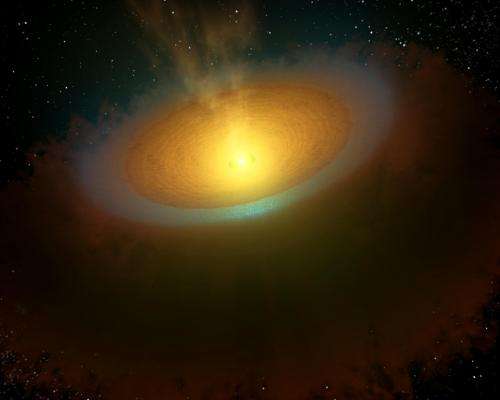Herschel finds past-prime star may be making planets

(Phys.org)—A star thought to have passed the age at which it can form planets may, in fact, be creating new worlds. The disk of material surrounding the surprising star called TW Hydrae may be massive enough to make even more planets than we have in our own solar system.
The findings were made using the European Space Agency's Herschel Space Telescope, a mission in which NASA is a participant.
At roughly 10 million years old and 176 light years away, TW Hydrae is relatively close to Earth by astronomical standards. Its planet-forming disk has been well studied. TW Hydrae is relatively young but, in theory, it is past the age at which giant plants already may have formed.
"We didn't expect to see so much gas around this star," said Edwin Bergin of the University of Michigan in Ann Arbor. Bergin led the new study appearing in the journal Nature. "Typically stars of this age have cleared out their surrounding material, but this star still has enough mass to make the equivalent of 50 Jupiters," Bergin said.
In addition to revealing the peculiar state of the star, the findings also demonstrate a new, more precise method for weighing planet-forming disks. Previous techniques for assessing the mass were indirect and uncertain. The new method can directly probe the gas that typically goes into making planets.
Planets are born out of material swirling around young stars, and the mass of this material is a key factor controlling their formation. Astronomers did not know before the new study whether the disk around TW Hydrae contained enough material to form new planets similar to our own.

"Before, we had to use a proxy to guess the gas quantity in the planet-forming disks," said Paul Goldsmith, the NASA project scientist for Herschel at NASA's Jet Propulsion Laboratory in Pasadena, Calif. "This is another example of Herschel's versatility and sensitivity yielding important new results about star and planet formation."
Using Herschel, scientists were able to take a fresh look at the disk with the space telescope to analyze light coming from TW Hydrae and pick out the spectral signature of a gas called hydrogen deuteride. Simple hydrogen molecules are the main gas component of planets, but they emit light at wavelengths too short to be detected by Herschel. Gas molecules containing deuterium, a heavier version of hydrogen, emit light at longer, far-infrared wavelengths that Herschel is equipped to see. This enabled astronomers to measure the levels of hydrogen deuteride and obtain the weight of the disk with the highest precision yet.
"Knowing the mass of a planet-forming disk is crucial to understanding how and when planets take shape around other stars," said Glenn Wahlgren, Herschel program scientist at NASA Headquarters in Washington.
Whether TW Hydrae's large disk will lead to an exotic planetary system with larger and more numerous planets than ours remains to be seen, but the new information helps define the range of possible planet scenarios.
"The new results are another important step in understanding the diversity of planetary systems in our universe," said Bergin. "We are now observing systems with massive Jupiters, super-Earths, and many Neptune-like worlds. By weighing systems at their birth, we gain insight into how our own solar system formed with just one of many possible planetary configurations."
More information: "An old disk that can still form a planetary system," by E. Bergin et al, is published in Nature, 31 January 2013. www.nature.com/nature/journal/ … ull/nature11805.html
Journal information: Nature
Provided by NASA





















